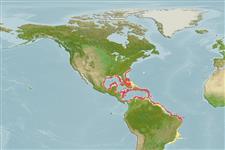>
Eupercaria/misc (Various families in series Eupercaria) >
Lutjanidae (Snappers) > Etelinae
Etymology: Etelis: Greek, etelis, -idos = a fish, perhaps the fish Sparus aurata (Ref. 45335).
More on author: Valenciennes.
Environment: milieu / climate zone / rango de profundidad / distribution range
Ecología
marino batidemersal; rango de profundidad 100 - 450 m (Ref. 9626). Deep-water; 37°N - 25°S, 8°E - 32°W
Western Atlantic: Bermuda and North Carolina, USA, Gulf of Mexico southward through the Caribbean to Sau Paulo, Brazil (Ref. 55), including the Fernando do Noronha and Atol das Rocas Islands (Ref. 113956).
Length at first maturity / Tamaño / Peso / Age
Madurez: Lm 31.0, range 35 - ? cm
Max length : 100.0 cm TL macho / no sexado; (Ref. 9626); common length : 64.0 cm TL macho / no sexado; (Ref. 6912); peso máximo publicado: 6.3 kg (Ref. 56081)
Espinas dorsales (total) : 10; Radios blandos dorsales (total) : 11; Espinas anales: 3; Radios blandos anales: 8. Head small; eye large; snout short. Maxilla covered with small scales; lower jaw slightly projecting. Dorsal and anal fin bases without scales; caudal fin deeply forked. Scale rows on the back running parallel with the lateral line. Back and upper sides deep pink to red; lower sides and belly pink; fins pink except the spinous portion of the dorsal fin; entire caudal fin brilliant red.
Body shape (shape guide): fusiform / normal; Cross section: oval.
Adults inhabit rocky bottoms and feeds mainly on small fishes and squids. They are abundant near oceanic islands (Ref. 9626). Small individuals are taken as by-catch in trawl fisheries (Ref. 5217). Marketed mostly fresh, sometimes frozen. Flesh of good quality.
Life cycle and mating behavior
Madurez | Reproducción | Puesta | Huevos | Fecundidad | Larva
Allen, G.R., 1985. FAO Species Catalogue. Vol. 6. Snappers of the world. An annotated and illustrated catalogue of lutjanid species known to date. FAO Fish. Synop. 125(6):208 p. Rome: FAO. (Ref. 55)
IUCN Red List Status (Ref. 130435: Version 2025-1)
Threat to humans
Harmless
Human uses
Pesquerías: comercial; pesca deportiva: si
Herramientas
Special reports
Download XML
Fuentes de Internet
Estimates based on models
Preferred temperature (Referencia
123201): 13.3 - 22.7, mean 18.3 °C (based on 73 cells).
Phylogenetic diversity index (Referencia
82804): PD
50 = 0.5312 [Uniqueness, from 0.5 = low to 2.0 = high].
Bayesian length-weight: a=0.01698 (0.01382 - 0.02086), b=2.93 (2.87 - 2.99), in cm total length, based on LWR estimates for this species (Ref.
93245).
Nivel trófico (Referencia
69278): 4.2 ±0.57 se; based on food items.
Generation time: 3.8 ( na - na) years. Estimated as median ln(3)/K based on 2
growth studies.
Resiliencia (Referencia
120179): Medio, población duplicada en un tiempo mínimo de 1.4-4.4 años (K=0.29-0.61).
Prior r = 0.24, 95% CL = 0.16 - 0.36, Based on 1 data-limited stock assessment.
Fishing Vulnerability (Ref.
59153): Low to moderate vulnerability (34 of 100).
🛈
Nutrients (Ref.
124155): Calcium = 20.6 [8.4, 56.2] mg/100g; Iron = 0.501 [0.218, 1.134] mg/100g; Protein = 18.2 [16.1, 20.1] %; Omega3 = 0.387 [0.185, 0.742] g/100g; Selenium = 21.5 [8.7, 53.3] μg/100g; VitaminA = 7.31 [1.36, 42.54] μg/100g; Zinc = 0.252 [0.166, 0.397] mg/100g (wet weight);
